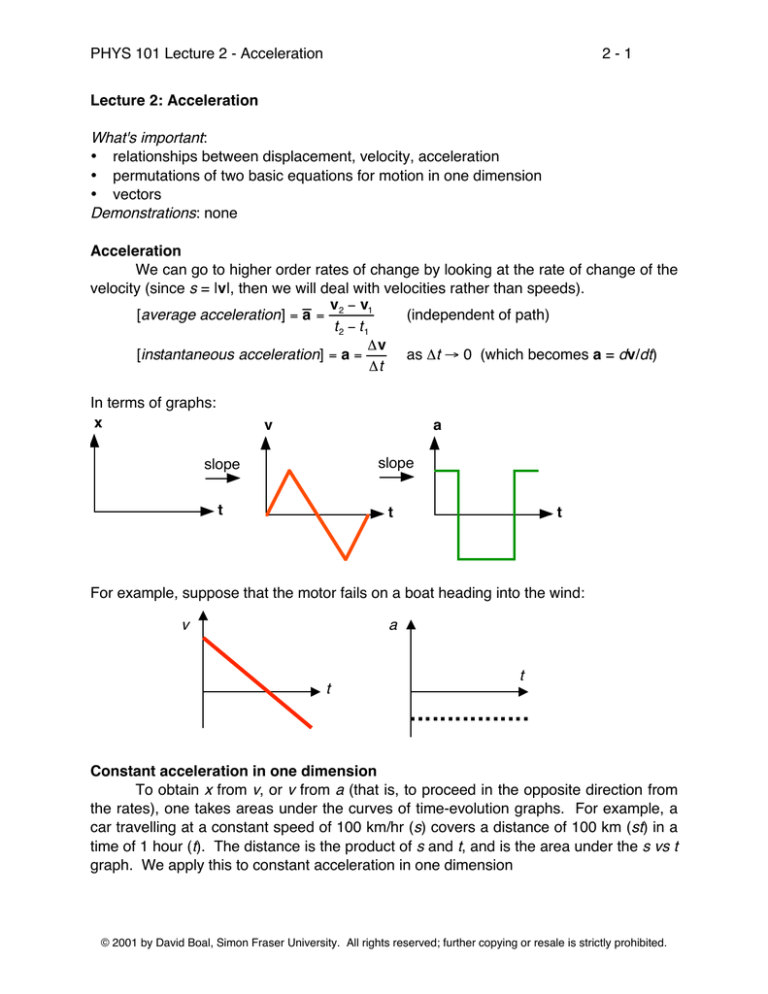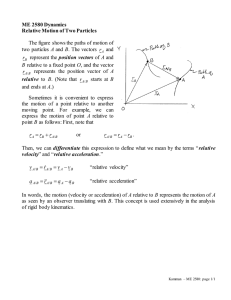
PHYS 101 Lecture 2 - Acceleration
2-1
Lecture 2: Acceleration
What's important:
• relationships between displacement, velocity, acceleration
• permutations of two basic equations for motion in one dimension
• vectors
Demonstrations: none
Acceleration
We can go to higher order rates of change by looking at the rate of change of the
velocity (since s = |v|, then we will deal with velocities rather than speeds).
v ! v1
(independent of path)
[average acceleration] = a = 2
t2 ! t1
!v
as Δt → 0 (which becomes a = dv/dt)
[instantaneous acceleration] = a =
!t
In terms of graphs:
x
v
a
slope
slope
t
t
t
For example, suppose that the motor fails on a boat heading into the wind:
v
a
t
t
Constant acceleration in one dimension
To obtain x from v, or v from a (that is, to proceed in the opposite direction from
the rates), one takes areas under the curves of time-evolution graphs. For example, a
car travelling at a constant speed of 100 km/hr (s) covers a distance of 100 km (st) in a
time of 1 hour (t). The distance is the product of s and t, and is the area under the s vs t
graph. We apply this to constant acceleration in one dimension
© 2001 by David Boal, Simon Fraser University. All rights reserved; further copying or resale is strictly prohibited.
2-2
acceleration
a→v
a
area
→
area = at
velocity
PHYS 101 Lecture 2 - Acceleration
vo
t
t
The area under the curve gives the change in v (that is, Δv = v - vo), NOT v itself.
From the graph of constant acceleration vs t,
Δv = area under a vs t = at
⇒ v - vo = at
⇒ v = vo + at
(1)
Eq. (1) shows that the v vs t curve should be a straight line with a y-intercept of vo.
v→x
v
vo
x
! area = ( v - vo)t/2
--area-->
! area = vot
t
Δx = area under v vs t = (v - vo)t /2 + vot
⇒ x - xo = (v + vo)t /2
⇒ x = (v + vo)t /2
(if xo = 0)
t
(2)
Although (2) looks like a linear equation in time (whereas the x vs. t is anything but
linear), in fact v contains time dependence. Substituting (1) into (2) to show the explicit
time-dependence gives
x = (vo + at + vo)t /2 = (2vo + at)t /2
⇒ x = vot + (1/2)at 2
(3)
To confirm that the form of Eq. (3) is correct, take derivatives to obtain v and a.
Equations (1) and (2) can be written in other ways as well. For example, since the plot
of v vs. t is linear, then the average velocity vav is just (v + vo)/2. Hence, Eq. (2) also can
be written as
x = vavt
(4)
Alternatively, one could invert (1) to find t,
t = (v - vo)/a
and substitute the result into (2) to obtain
x = (v2 - vo2) / 2a
(5)
© 2001 by David Boal, Simon Fraser University. All rights reserved; further copying or resale is strictly prohibited.
PHYS 101 Lecture 2 - Acceleration
2-3
a
area
→
area = at
velocity
acceleration
Variable acceleration in one dimension
Eqs. (2) - (5) only hold if the acceleration is constant. If it is not constant, the area under
the a vs. t curve must be determined by some analytic or numerical means:
t
t
Vectors
In this course, we are concerned with motion in three dimensions, and this requires us
to use vectors.
Scaler: a quantity with
magnitude only,
e.g. distance.
z
Vector: a quantity with
magnitude and direction,
e.g. position.
Position
Coordinate
origin
y
!
Denote position vector as R.
This is called the
displacement of the object
with respect to the origin.
x
Addition:
The addition of vectors is not the same procedure as the addition of scalers:
!
!
B
A
!
!
Add A to B
!
!
!
!
Addition rule: put tip of A to tail of B, resultant runs from tail of A to tip of B.
!
!
B
A
! ! !
Resultant C = A + B
Note that the order in which the vectors are added doesn’t matter.
© 2001 by David Boal, Simon Fraser University. All rights reserved; further copying or resale is strictly prohibited.
PHYS 101 Lecture 2 - Acceleration
2-4
Subtraction:
!
Form negative of B,
then add as usual.
! !
A - B
!
A
-
!
B
"
!
A
+
!
-B
!
-B
"
!
C
!
A
Magnitude:
→
The length of vector →
A is denoted by |A|.
Scaler times vector:
!
! ! !
a A = A + A + A .....
“a” times.
Multiplication:
There are three products that one can form from vectors, two of which (the dot and
cross product) are needed in this course. The dot product of two vectors is a scalar
quantity, and hence the dot product also is called the scalar product. The notation for
the dot product, and its operation, are:
! !
! !
=
| A | | B | cos "
A
B
this is the angle
between the vectors
here!s the dot
This operation is equivalent to taking the projection of one vector times the length of the
other:
!
A
"
!
B
This length is A cos "
Note that the dot product of a vector with itself is just the square of the vector’s length
→ → → →
A • A = |A| |A| cos(0) = A2
It is often useful to represent vectors in terms of their Cartesian components:
A = (ax, ay, az).
Then
A + B = (ax+bx, ay+by, az+bz)
and
A • B = (axbx, ayby, azbz).
© 2001 by David Boal, Simon Fraser University. All rights reserved; further copying or resale is strictly prohibited.




